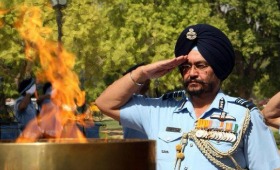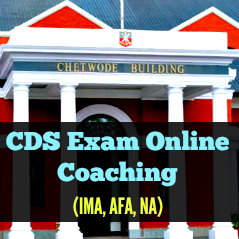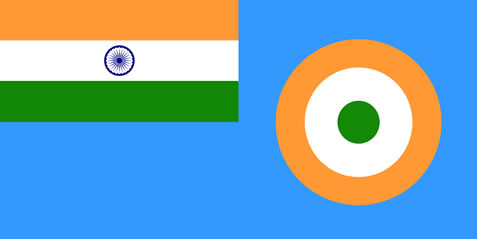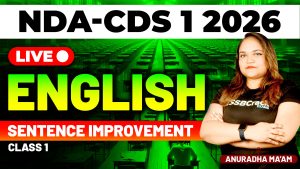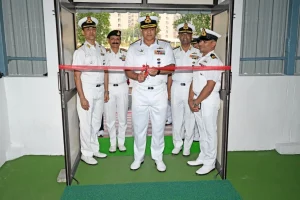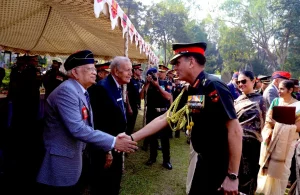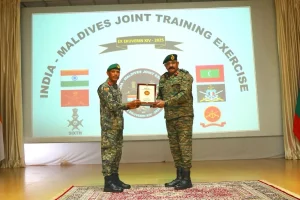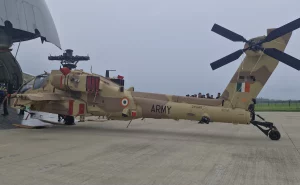CDS exam and all entrance exams have general knowledge in common of their syllabus, since they are defence armed forces entrance exam they contain questions based on Indian Armed Forces, In this article we will discuss facts on CDS 2 2017 Exam General Knowledge Indian Army Airforce Navy
CDS 2 2017 Exam General Knowledge Indian Army Airforce Navy
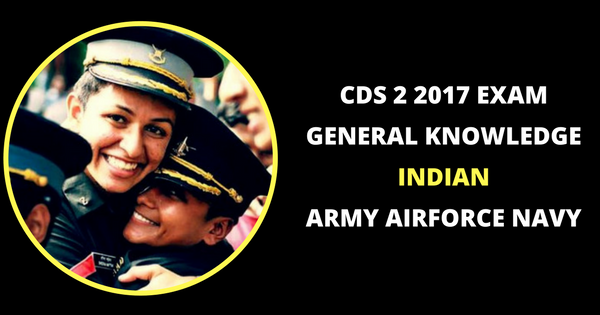
CDS EXAM COACHING
Indian Army
The Indian Army has approximately 13 lakhs men and women in its ranks. The President of India is the Supreme Commander of the three services – Army, Navy and Air Force. The Army headquarters is in New Delhi and it is under the direction of the Chief of the Army staff. He is a four star General and is assisted by 8 Lt. Generals who are one vice chief, two deputy chiefs, a military secretary, An adjutant General, the quartermaster general, the master general of ordnance and the engineer in Chief. Two officers have been conferred the rank of field marshal – Field Marshal K M Cariappa and Field Marshal Sam Manekshaw, a 5-star rank and the officer serves as the ceremonial chief. Since independence, the Indian army has been involved in 4 wars with neighboring Pakistan and one with the People’s Republic of China. Other major operations undertaken by the army include Operation Vijay – Kargil War in 1999, Operation Meghdoot – to gain control over Siachen Glacier in 1984 and Operation Cactus – to stop a Military Coup in Maldives in 1988.
- Roles of the Indian Army
Its primary mission is to ensure the national security and safeguard sovereignty, territorial integrity and unity of India from external aggression and threats.
Secondary roles include providing humanitarian support and aid to civil authority during calamities and natural disasters.
- Flag of the Indian Army
- Commands of the Indian Army
The commands of Indian Army is divided in to 6 operational and 1 training command each headed by Lt. General:
- Central Command: headquartered at Lucknow, Uttar Pradesh
-
- I Corps — Currently assigned to South Western Command
- Eastern Command: headquartered at Kolkata, West Bengal
- 23rd Infantry Division headquartered at Ranchi
- III Corps, headquartered at Dimapur, Nagaland
- IV Corps, headquartered at Tezpur, Assam
- XXXIII Corps, headquartered at Siliguri, West Bengal
- Northern Command: headquartered at Udhampur, Jammu and Kashmir
- XIV Corps, headquartered at Leh, Jammu and Kashmir
- XV Corps, headquartered at Srinagar, Jammu and Kashmir
- XVI Corps, headquartered at Nagrota, Jammu and Kashmir
- Southern Command: headquartered at Pune, Maharashtra
- 41st Artillery Division, headquartered at Pune, Maharashtra
- XII Corps, headquartered at Jodhpur, Rajasthan
- XXI Corps, headquartered at Bhopal, Madhya Pradesh
- South Western Command: headquartered at Jaipur, Rajasthan
- 42nd Artillery Division headquartered at Jaipur
- I Corps, headquartered at Mathura, Uttar Pradesh
- X Corps, headquartered at Bhatinda, Punjab
- Western Command: headquartered at Chandimandir
- 40th Artillery Division headquartered at Ambala
- II Corps, headquartered at Ambala, Haryana
- IX Corps, headquartered at Yol, Himachal Pradesh
- XI Corps, headquartered at Jalandhar, Punjab
- Training Command: headquartered at Shimla, Himachal Pradesh
Organisation of the Indian Army
The Army is Organised in Two Parts:
- Arms:
- Indian Infantry Regiments
- Armoured Corps Regiments – The Armoured Corps Centre and School is at Ahmednagar.
- Regiment of Artillery – The School of Artillery is at Devlali near Nasik.
- Corps of Signals – Military College of Telecommunication Engineering (MCTE), Mhow is a premiere training institute for the officers of the Corps of Signals. The corps also has two Signal Training Centres at Jabalpur and Goa.
- Corps of Engineers – The College of Military Engineering is at Dapodi, Pune. The centres are located as follows – Madras Engineer Group at Bangalore, Bengal Engineer Group at Roorkee and Bombay Engineer Group at Khadki, Pune.
- Corps of Army Air Defence — Centre at Gopalpur in Odisha.
- Mechanised Infantry – Regimental Centre at Ahmednagar.
- Army Aviation Corps(India) – Their training establishment, Combat Army Aviation Training School, is based in Nasik.
- Intelligence Corps – Centre at Pune
- Services:
| Name | Centre |
| Army Dental Corps | Lucknow |
| Army Education Corps | Pachmarhi |
| Army Medical Corps | Lucknow/Pune |
| Army Ordnance Corps | Jabalpur and Secunderabad (HQ) |
| Army Postal Service Corps | Kamptee near Nagpur |
| Army Service Corps | Bangalore |
| Corps of Electronics and Mechanical Engineers | Secunderabad |
| Corps of Military Police | Bangalore |
| Intelligence Corps | Pune |
| Judge Advocate General’s Department | Institute of Military Law Kamptee, Nagpur |
| Military Farms Service | Military Farms School and Centre, Meerut Cantonment |
| Military Nursing Service | Pune and Lucknow |
| Remount and Veterinary Corps | Meerut |
| Pioneer Corps | Bangalore |
- Formations of the Indian Army
- Division: Each Division is headed by General Officer Commanding (GOC) in the rank of Major General. It usually consists of 15,000 combat troops and 8,000 support elements. Currently, the Indian Army has 37 Divisions including; 4 RAPID (Re-organized Army Plains Infantry Divisions) Action Divisions, 18 Infantry Divisions, 10 Mountain Divisions, 3 Armored Divisions and 2 Artillery Divisions. Each Division composes of several Brigades.
- Brigade: A Brigade generally consists of around 3,000 combat troops with supporting elements. An Infantry Brigade usually has 3 Infantry Battalions along with various Support Arms & Services. It is headed by a Brigadier. In addition to the Brigades in various Army Divisions, the Indian Army also has 5 Independent Armored Brigades, 15 Independent Artillery Brigades, 7 Independent Infantry Brigades, 1 Independent Parachute Brigade,3 Independent Air Defence Brigades, 2 Independent Air Defence Groups and 4 Independent Engineer Brigades. These Independent Brigades operate directly under the Corps Commander (GOC Corps).
- Battalion: A Battalion is commanded by a Colonel and is the Infantry’s main fighting unit. It consists of more than 900 combat personnel.
- Company: Headed by the Major or Captain, a company comprises 120 soldiers.
- Platoon: An intermediate between a company and section, a platoon is headed by a Captain or Lieutenant, or depending on the availability of commissioned officers, even a junior commissioned officer (Subedar). It has a total strength of about 32 troops.
- Section: Smallest military outfit with a strength of 10 personnel. Commanded by a non-commissioned officer of the rank of Havildar or Sergeant.
Ranks and Promotion Structure of the Indian Army
Types of Promotion:
| Acting Promotion in Peace and field concessional Areas. | |
| SubstantivePromotion | Time Scale (up to Lt Col), Selection Grade (Col and above) |
| Local Rank | Local ranks appropriate to the appointments held may be granted to the officers if considered necessary in terms of DSR Para 88. |
Years of Reckonable Commissioned Service for Acting Promotion:
| Rank to Which ActingPromotion is Made | Total Minimum Serviceas Commissioned Officer | Remarks | |
| Captain | 1 year | – | |
| Major | 4 years | 3 years in Field. | |
| Lieutenant Colonel | 7 years | With minimum service of one years in the rank of substantive Major. | |
| Colonel | 8 years & 6 months | With minimum service of two years in the rank (s) of Major and above. | |
| Brigadier | 12 years | With minimum service of three years in rank(s) of Lt. Col and above. | |
| Major General | 20 years | – | |
| Lieutenant General | 25 years | – | |
Years of Reckonable Commissioned Service for Substantive Promotion (Other than AMC/ADC):
| Rank | Major Arms/Service | Vet Officers | MF | SL |
| Capt | 2 | 1 | 2 | 2 |
| Maj | 6 | 7 | 6 | 6 |
| Lt Col | 13 | 17 | 13 | 13 |
| Col(TS) | 26 | – | 26 | 26 |
| Col(Selection) | 15 | 15 | 15 | 15 |
| Brig | 23(22)* | – | – | – |
| Maj Gen | 25(24)* | – | – | – |
| Lt Gen | 28 | – | – | – |
| Gen | No restriction | – | – | – |
- Gallantry Medals of the Indian Army
The medals awarded by President of India for gallantry displayed at the battlefield, in order of precedence, are- Param Vir Chakra, Maha Vir Chakra and Vir Chakra. The medals awarded by the President for gallantry displayed away from the battlefield, in order of precedence, are- Ashoka Chakra, Kirti Chakra and Shaurya Chakra. Many of the recipients of the above awards have been Indian Army personnel.
Indian Air Force
- Formation of Indian Air Force
The Indian Air Force’s History precedes World War Two by eight years. The IAF was established by on 8 Oct 1932 when its formation was announced in the Gazette of India. No.1 Squadron formed at Drigh Road in Karachi on 1 April 1933 with a complement of six Indian Officers under the command of a British Officer.
Formation and early pilot
The Indian Air Force was established in British India as an auxiliary air force of the Royal Air Force with the enactment of the Indian Air Force Act 1932 on 8 October that year and adopted the Royal Air Force uniforms, badges, brevets and insignia. On 1 April 1933, the IAF commissioned its first squadron, No.1 Squadron, with four Westland Wapiti biplanes and five Indian pilots. The Indian pilots were led by RAF Commanding officer Flight Lieutenant (later Air Vice Marshal) Cecil Bouchier.
- Motto of Indian Air Force
The Motto of Indian Air Force has been taken from eleventh chapter of the Gita, the Discourse given by Lord Krishna to Arjuna on the battlefield of Kurukshetra during the Great War of Mahabharata. The Lord is showing His Supreme Divine form to Arjuna and the great form of the Lord is reaching the sky with glory, evoking fear and loss of self-control in the mind of Arjuna.The Indian Air Force, similarly, aims to overwhelm the adversaries with application of aerospace power in defence of the nation.
- Flag of Indian Air Force
- Contribution and Service by Indian Air Force
World War II (1939–1945)
During World War II, the IAF played an instrumental role in blocking the advance of the Japanese army in Burma, where its first air strike was on the Japanese military base in Arakan. It also carried out strike missions against the Japanese airbases at Mae Hong Son, Chiang Mai and Chiang Rai in northern Thailand.
The IAF was mainly involved in Strike, Close Air Support, Aerial reconnaissance, Bomber Escort and Pathfinding missions for RAF and USAAF Heavy bombers. RAF Pilots were embedded in IAF units and vice versa to gain combat experience. IAF pilots participated in air operations in Europe as part of the RAF.[18]
During the war, the IAF went through a phase of steady expansion. New aircraft, including the U.S. built Vultee Vengeance, Douglas DC-3 and the British Hawker Hurricane, Supermarine Spitfire and Westland Lysander, were added to its fleet.
In recognition of the services rendered by the IAF, King George VI conferred the prefix “Royal” in 1945. Thereafter the IAF was referred to as the Royal Indian Air Force. In 1950, when India became a republic, the prefix was dropped and it reverted to being the Indian Air Force.
First years of independence (1947–1950)
After become independent from the British Empire in 1947, British India was partitioned into the new states of the Dominion of India and the Dominion of Pakistan. Along the lines of the geographical partition, the assets of the air force were divided between the new countries. India’s air force retained the name of the Royal Indian Air Force, but three of the ten operational squadrons and facilities, located within the borders of Pakistan, were transferred to the Royal Pakistan Air Force.[19] The RIAF Roundel was changed to an interim ‘Chakra’ roundel derived from the Ashoka Chakra.
Around the same time, conflict broke out between them over the control of the princely state of Jammu & Kashmir. With Pakistani forces moving into the state, its Maharaja decided to accede to India in order to receive military help. The day after, the Instrument of Accession was signed, the RIAF was called upon to transport troops into the war zone. And this was when a good management of logistics came into help. This led to the eruption of full-scale war between India and Pakistan, though there was no formal declaration of war. During the war, the RIAF did not engage the Pakistan Air Force in air-to-air combat; however, it did provide effective transport and close air support to the Indian troops.
Kargil War (1999)
On 11 May 1999, the Indian Air Force was called in to provide close air support to the Indian Army at the height of the ongoing Kargil conflict with the use of helicopters.The IAF strike was code named Operation Safed Sagar. The first strikes were launched on 26 May, when the Indian Air Force struck infiltrator positions with fighter aircraft and helicopter gunships. The initial strikes saw MiG-27s carrying out offensive sorties, with MiG-21s and later MiG-29s providing fighter cover. The IAF also deployed its radars and the MiG-29 fighters in vast numbers to keep check on Pakistani military movements across the border. Srinagar Airport was at this time closed to civilian air-traffic and dedicated to the Indian Air Force.
On 27 May, the Indian Air Force suffered its first fatality when it lost a MiG-21 and a MiG-27 in quick succession. The following day, while on an offensive sortie, a Mi-17 was shot down by three Stinger missiles and lost its entire crew of four. Following these losses the IAF immediately withdrew helicopters from offensive roles as a measure against the threat of Man-portable air-defence systems (MANPAD). On 30 May, the Mirage 2000s were introduced in offensive capability, as they were deemed better in performance under the high-altitude conditions of the conflict zone. Mirage 2000s were not only better equipped to counter the MANPAD threat compared to the MiGs, but also gave IAF the ability to carry out aerial raids at night. The MiG-29s were used extensively to provide fighter escort to the Mirage 2000. Radar transmissions of Pakistani F-16s were picked up repeatedly, but these aircraft stayed away. The Mirages successfully targeted enemy camps and logistic bases in Kargil and severely disrupted their supply lines. Mirage 2000s were used for strikes on Muntho Dhalo and the heavily defended Tiger Hill and paved the way for their early recapture. At the height of the conflict, the IAF was conducting over forty sorties daily over the Kargil region. By 26 July, the Indian forces had successfully repulsed the Pakistani forces from Kargil.
- Structure of Indian Air Force
The President of India is the Supreme Commander of all Indian armed forces and by virtue of that fact is the national Commander-in-chief of the Air Force. Chief of the Air Staff with the rank of Air Chief Marshal is the Commander of the Indian Air Force. He is assisted by six officers, all with the rank of Air Marshal:
- Vice Chief of the Air Staff
- Deputy Chief of the Air Staff
- Air Officer in Charge of Administration
- Air Officer in Charge of Personnel
- Air Officer in Charge of Maintenance
- Director General of Inspection and Flight Safety.
Operational Commands
- Central Air Command (CAC), headquartered at Allahabad, Uttar Pradesh
- Eastern Air Command (EAC), headquartered at Shillong, Meghalaya
- Southern Air Command (SAC), headquartered at Thiruvananthapuram, Kerala
- South Western Air Command (SWAC), headquartered at Gandhinagar, Gujarat
- Western Air Command (WAC), headquartered at New Delhi
Functional Commands
- Training Command (TC), headquartered at Bangalore, Karnataka
- Maintenance Command (MC), headquartered at Nagpur, Maharashtra
Wings
A Wing is a formation intermediate between a Command and a Squadron. It generally consists of two or three IAF Squadrons and Helicopter Units, along with Forward Base Support Units (FBSU). FBSUs do not have or host any Squadrons or Helicopter units but act as transit airbases for routine operations. In times of war, they can become fully fledged air bases playing host to various Squadrons. In all, about 47 Wings and 19 FBSUs make up the IAF. Wings are typically
Squadrons and Units
Squadrons are the field units and formations attached to static locations. Thus, a Flying Squadron or Unit is a sub-unit of an air force station which carries out the primary task of the IAF. A fighter squadron consists of 18 aircraft; all fighter squadrons are headed by a Commanding Officer with the rank of Wing Commander. Some Transport squadrons and Helicopter Units are headed by a Commanding Officer with the rank of Group Captain.
Sections
The smallest unit is the section, led by a Flight Lieutenant. Each section consists of three aircraft.
Within this formation structure, IAF has several service branches for day-to-day operations. They are:
Flying Branch
|
Technical Branch
|
Ground Branch
|
- Rank structure of Indian Air Force
The rank structure of the Indian Air Force is based on that of the Royal Air Force. The highest rank attainable in the IAF is Marshal of the Indian Air Force, conferred by the President of India after exceptional service during wartime. MIAF Arjan Singh is the only officer to have achieved this rank. The head of the Indian Air Force is the Chief of the Air Staff, who holds the rank of Air Chief Marshal.
Officers
- List of Indian Air Force Medals and Awards
- PARAM VIR CHAKRA
Circular in shape, made of bronze, one and three eighth inches in diameter and on obverse, four replicas of “Indra’s Vajra” with the State Emblem (including the motto), embossed in the centre. On its reverse, it shall have embossed Param Vir Chakra both in Hindi and English with two lotus flowers between Hindi and English. The fitting will be swivel mounting.
- MAHAVIR CHAKRA
The following categories of personnel shall be eligible for the Chakra :-
- Officers, men and women of all ranks of the Army, the Navy and the Air Force, of any of the Reserve Forces, of the Territorial Army, Militia and of any other lawfully constituted Armed Forces.
- Matrons, Sisters, Nurses and the staff of the Nursing Services and other Services pertaining to Hospitals and Nursing and Civilians of either sex serving regularly or temporarily under the orders, directions or supervision of any of the above-mentioned Forces.
- ASHOKA CHAKRA
The following categories of personnel shall be eligible for the Chakra :-
- Officers, men and women of all ranks of the Army, the Navy and the Air Force, of any of the Reserve Forces, of the Territorial Army, Militia and of any other lawfully constituted Armed Forces.
- Members of the Nursing Services of the Armed Forces.
- Civilian citizens of either sex in all walks of life and members of Police Forces including Central Para-Military Forces and Railway Protection Force.
- KIRTI CHAKRA
The following categories of personnel shall be eligible for the Chakra :-
- Officers, men and women of all ranks of the Army, the Navy and the Air Force, of any of the Reserve Forces, of the Territorial Army, Militia and of any other lawfully constituted Armed Forces.
- Members of the Nursing Services of the Armed Forces.
- Civilian citizens of either sex in all walks of life and members of Police Forces including Central Para-Military Forces and Railway Protection Force.
- VIR CHAKRA
The following categories of personnel shall be eligible for the Chakra :-
- Officers, men and women of all ranks of the Army, the Navy and the Air Force, of any of the Reserve Forces, of the Territorial Army, Militia and of any other lawfully constituted Armed Forces.
- Matrons, Sisters, Nurses and the staff of the Nursing Services and other Services pertaining to Hospitals and Nursing and Civilians of either sex serving regularly or temporarily under the orders, directions or supervision of any of the above-mentioned Forces.
- SHAURYA CHAKRA
The following categories of personnel shall be eligible for the Chakra :-
- Officers, men and women of all ranks of the Army, the Navy and the Air Force, of any of the Reserve Forces, of the Territorial Army, Militia and of any other lawfully constituted Forces.
- Members of the Nursing Services of the Armed Forces.
- Civilian citizens of either sex in all walks of life and members of Police Forces including Central Para-Military Forces and Railway Protection Force.
- SARVOTTAM YUDH SEVA MEDAL
The following categories of personnel shall be eligible for the medal: –
- All ranks of the Army, the Navy and the Air Force including those of Territorial Army Units, Auxiliary and Reserve Forces and other lawfully constituted Armed Forces when embodied.
- Nursing officers and other members of the Nursing Services in the Armed Forces.
- UTTAM YUDH SEVA MEDAL
The following categories of personnel shall be eligible for the medal :-
- All ranks of the Army, the Navy and the Air Force including those of Territorial Army Units, Auxiliary and Reserve Forces and other lawfully constituted Armed Forces when embodied.
- Nursing officers and other members of the Nursing Services in the Armed Forces.
- YUDDH SEVA MEDAL
The following categories of personnel shall be eligible for the award of the Medal:-
- All ranks of the Army, the Navy and the Air Force including Territorial Army Units, Auxiliary and Reserve Forces (when embodied) and other lawfully constituted Armed Forces.
- Nursing officers and other members of the Nursing Services in the Armed Forces.
- PARAM VISHISHT SEVA MEDAL
The following categories of personnel shall be eligible for the medal :-
- All ranks of the Army, the Navy and the Air Force including Territorial Army Units, Auxiliary and Reserve Forces (when embodied) and other lawfully constituted Armed Forces.
- Nursing officers and other members of the Nursing Services in the Armed Forces.
- ATI VISHISHT SEVA MEDAL
The following categories of personnel shall be eligible for the medal :-
- All ranks of the Army, the Navy and the Air Force including Territorial Army Units, Auxiliary and Reserve Forces (when embodied) and other lawfully constituted Armed Forces.
- Nursing officers and other members of the Nursing Services in the Armed Forces.
- VISHISHT SEVA MEDAL
The following categories of personnel shall be eligible for the medal :-
- All ranks of the Army, the Navy and the Air Force including Territorial Army Units, Auxiliary and Reserve Forces (when embodied) and other lawfully constituted Armed Forces.
- Nursing officers and other members of the Nursing Services in the Armed Forces.
- VAYU SENA MEDAL
The following categories of personnel shall be eligible for the award of the Medal:-
- Officers and airmen of the Regular Air Force and officers and airmen of Auxiliary Air Force, Air Defence Reserve and Regular Reserve when called upon under Section 25 of the Reserve and Auxiliary Air Force Act, 1952.
- Army officers serving as pilots in Aviation Corp. will also be eligible for the award of this Medal.
Indian Navy
Principal Roles of Indian Navy
Currently the principal roles of Indian Navy are:
- In conjunction with other Armed Forces of the union, act to deter or defeat any threats or aggression against the territory, people or maritime interests of India, both in war and peace;
- Project influence in India’s maritime area of interest, to further the nation’s political, economic and security objectives;
- In co-operation with the Indian Coast Guard, ensure good order and stability in India’s maritime zones of responsibility.
- Provide maritime assistance (including disaster relief) in India’s maritime neighbourhood.
Roles and Ranks in Indian Navy
- Chief of the Naval Staff
(An Admiral Rank Officer)
- Chief of Naval Staff
| At IHQ MOD (N) Level | At Operational Commands Level |
| Vice Chief of Naval Staff | Flag Officer Commanding in Chief,Western Naval Command |
| Deputy Chief of Naval Staff | Flag Officer Commanding in Chief,Eastern Naval Command |
| Chief of Personnel | Flag Officer Commanding in Chief,Southern Naval Command |
| Chief of Materiel | Other Independent Authorities |
| Commander in Chief , Andaman & Nicobar Command | Other Independent Authorities |
- Naval Authorities under Administrative Control of Flag Officers Commanding in Chief
| Flag Officer Commanding In ChiefWestern Naval Command | Flag Officer Commanding In ChiefEastern Naval Command | Flag Officer Commanding In ChiefSouthern Naval Command |
| FOCWF | FOCEF | COMMANDANT,INDIAN NAVAL ACADEMY |
| FOMAG | ASD (VISAKHAPATNAM) | FOST |
| COMCOS (WEST) | COMCOS (EAST) | ASY (KOCHI) |
| FOGA | NOIC (ANDHRA PRADESH) | NOIC (KERALA) |
| FONA | NOIC (TAMIL NADU) | NOIC (LAKSHADWEEP) |
| FODAG | NOIC (ORISSA) | SHORE ESTABLISHMENTS |
| FOK | NOIC (WEST BENGAL) | TRAINING SCHOOLS / ESTABLISHMENTS |
| ASD (MUMBAI) | SHORE ESTABLISHMENTS | |
| NOIC (MAHARASTRA) | ||
| NOIC (GUJRAT) | ||
| NOIC (KARNATAKA) | ||
| NOIC (GOA) | ||
| SHORE ESTABLISHMENTS |
Rank Structure
Commands of Indian Navy
| Mumbai | Visakhapatnam | Kochi | Port Blair | |
| Commands | Western Naval Command | Eastern Naval Command | Southern Naval Command | Andaman & Nicobar Command |
| Headed By | Flag Officer Commanding in Chief, WNC | Flag Officer Commanding in Chief, ENC | Flag Officer Commanding in Chief, SNC | Commander-in-Chief, ANC |
| Command Authorities & Units | Units of WNC | Units of ENC | Units of SNC | Units of ANC |
- Medals In The Indian Navy
- Param Vir Chakra
- Ashok Chakra
- Sarvottam Yudh Seva Medal
- Param Vishisht Seva Medal
- Mahavir Chakra
- Kirti Chakra
- Uttam Yudh Seva Medal
- Ati Vishisht Seva Medal
- Vir Chakra
- Shaurya Chakra
- Yudh Seva Medal
- Sena/Nao Sena/Vayu Sena Medal
- Vishisht Seva Medal
- Wound Medal
- General Service Medal – 1947
- Samanya Seva Medal – 1965
- Special Service Medal
- Samar Seva Star – 1965
- Poorvi Star
- Paschimi Star
- Raksha Medal – 1965
- Sangram Medal
- Sainya Seva Medal
- Videsh Seva Medal
- Meritorious Service Medal
- Long Service & Good Conduct Medal
- 25th Independence Anniversary Medal
- 30 Year Long Service Medal
- 20 Year Long Service Medal
- 9 Year Long Service Medal
- Operations of The Indian Navy
- Operation Vijay (1961)
- Operation Trident (1971)
- Operation Python (1971)
- Operation Cactus (1988)
- During Operation Restore Hope (1992–2003)
- Operation Parakram (2001)
- During Operation Enduring Freedom (2001)
- During 2004 Indian Ocean earthquake (Operation Madath, Operation Sea Waves, Operation Castor, Operation Rainbow, Operation Gambhir & Operation Rahat-II)
- Operation Sukoon (2006)
- Operation Search Light-The Search Operation Undertaken by Indian Navy to find the missing Boieng 777 M.H 17 Malaysian Flight
- Operation Raahat (2015) – Operation by the Indian Armed Forces to evacuate Indian citizens and other foreign nationals from Yemen during the 2015 military intervention by Saudi Arabia and its allies in that country during the Yemeni Crisis.
